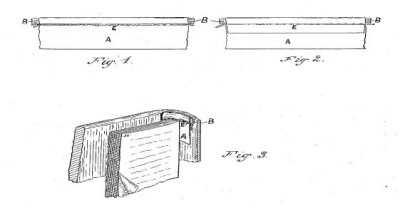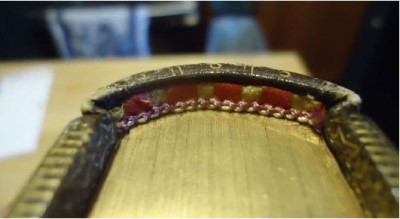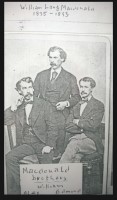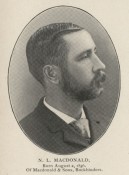In Quest of a Book Patent-Part 1
An article on Macdonald & Sons, Boston Bookbinders 1851-1920+
(First published in the Delaware Bibliophiles Endpapers, March 2018, pages 4-7. Reprinted here with permission of the author, who retains all copyrights)
In 1998, at the suggestion of fellow DB Tom Beckman, now departed, I took Sue Allen's course on 19th century book bindings at Rare Book School at the University of Virginia. One of the highlights during my week there was a visit to Jefferson's Rotunda, where the top floor is ringed with glazed bookcases filled with 19th century American publishers' bindings, typically in beautiful condition. These had been assembled over a number of years by Terry Belanger, the idiosyncratic head of RBS. One of his special interests are editions of Owen Meredith's Lucile, a popular verse novel written by Robert Bulwer-Lytton in 1860. This title was one of the most popular books in America in the 19th century, and publishers' editions form a great chronological history of the book in the period from 1860 to around 1900. Terry had managed to find over 400 different examples to illustrate the progression of binding styles during this period.
In my daily search of eBay books published between 1800 and 1900, I typically view around 12,000 thumbnails every day, looking for bindings of historical interest. Because Lucile is so popular, I often see examples, and if the condition is nice and price is right, I forward the eBay auctions to Barbara Heritage at RBS for possible purchase for their Lucile collection. Some books she buys outright, and other editions that appear less common she forwards to Sid Huttner at the University of Iowa to give him first refusal for his much larger Lucile collection, numbering over 1200 examples, as part of what is called The Lucile Project, a great online documentary history.
Recently, I saw a copy of a James Osgood 1884 edition of Lucile that I would normally forward immediately to RBS, but had second thoughts and decided to look into it further before sending on. It was an unusual, though to me not particularly attractive, leather binding that appeared to have numerous onlays of colored patches of leather.
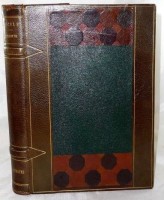
What caught my eye much more than the mosaic binding was a small gilt stamp on the bottom of the front paste down stating MACDONALD & SONS' BINDING followed by an even smaller gilt stamped PATENT APPL'D FOR.
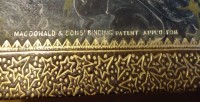
I am interested in signed bindings, and have just one in my collection by Macdonald & Sons, well respected binders in Cambridge, Massachusetts.
I immediately checked the online Lucile Project, which thoroughly covers the above mosaic binding. While the patent and rather extraordinary price of $12.50 for the mosaic binding was mentioned, no information about the patent was given. A contemporary article quoted says that the business was started in 1856 by the father Donald, a Scotch immigrant. When he died, it was taken over by his three sons William L., Edmund J. and Alexander L. Macdonald.
I wanted to find out more about the Macdonalds, so went to the standard binding references. Here I found that getting the correct information is made even more challenging when incorrect information is published and quickly becomes fact. For example, the following is quoted in a current M & S Rare Books ad featuring a $7500 copy of a Macdonald & Sons binding of the classic 1882 photography book Stillman's Horse in Motion: "Spawn & Kinsella, American Signed Bindings (2007), pp. 96-97, note four stamped bindings (no binder's labels) for Macdonald/Macdonald & Sons. S & K provide the following note: William L. Macdonald and sons (Macdonald & Sons) were bookbinders in Cambridge, Mass, 1860, 1868; the firm was located at 11 Chardon St., Boston, 1877; 51 Chardon St., 1879, and into the 1880s .... For illustrations of two Macdonald & Sons bindings ... see [F. Maser] Bookbinding in America, 1680-1910, entries 56 and 57."
This useful reference book on American Signed Bindings Through 1876 by Willman Spawn and Thomas Kinsella was co-published by Oak Knoll and Bryn Mawr, in whose collection all the aforementioned signed bindings are found. The book clearly states that William Macdonald was the father, so who was Donald?
I then checked entries 56 and 57 in the Maser book, Bookbinding in America, 1680-1910, published in 1983 by Bryn Mawr and edited by James Tanis, and here is what is said about Macdonald & Sons: "William L. Macdonald, founder of the firm, was joined in the directory listing for 1880 by his sons Edmund J. and Alexander L."
Two votes for William, and one for Donald as father.
Since these more recent books do not agree with the contemporary information that Donald was the father as noted in the Lucile Project, I began a fresh look and thoroughly researched online Cambridge city directories and genealogy databases. I conclude the information about the Macdonalds in both the Maser book and the Spawn & Kinsella book is incorrect.
The entire McDonald family emigrated from Scotland by early 1850, when they appeared in the 1850 Boston census mid-year. Initially, the father went by the name of Daniel McDonald. He is listed as a book binder in the Cambridge, Mass. city directories from 1851 to 1856. In 1857 he was joined by his eldest sons William (age 22) and Edmund (age 19), and by 1863 by his third son Alexander (age 22). Around this time, Daniel started using the name Donald, and the last name spelling was changed to Macdonald. Donald died in the late 1860s, and the three sons continued the business until Edmund died in 1887 and William died in 1893. Alexander continued to run the business with his sons until at least 1920, when he was 76 years old.
The change of the name Daniel to Donald was puzzling to me until I checked a Highland Roots genealogy web site. "Unfortunately English-speaking clerks in various parts of the Highlands had differing ideas as to what the appropriate English equivalent was for particular Gaelic names. One of the most common examples is the Gaelic name Domhnall which may be given in English as both Donald and Daniel; which means that researchers looking for records of a Daniel and failing to find them may have better luck looking for Donald instead."
Back to the book. The 1884 copy of Lucile is later than I generally collect, but the possibility of both an unusual signed binding and an unknown patent made this an exception. RBS suddenly lost out on this The reasonable presumption is that PATENT APPL'D FOR refers to the process for the manufacture of the mosaic designs, which are made from a large number of pieces of leather glued up in a mosaic pattern. Or, it could be for a design patent for the mosaic pattern. Or, perhaps a patent was applied for, but was never issued. The fact that no such United States patent had been located offered just the kind of challenge I like.
While waiting for the book to arrive from Seattle, it took me three intense sessions with Google to finally come up with the only patent issued to any Macdonald of the "Macdonald and Sons" clan. As those who do online patent searches know, the Optical Character Recognition (OCR) process used to scan patents is woefully inaccurate in picking up every word, and in this case I eventually found that Macdonald was read as Macdokald. To get around this, one must use other ways of fishing.
The procedure that finally worked was to look for all bookbinding-related patents issued between 1883 and 1886. I finally came up with just one Macdonald patent, US313875, issued to William Macdonald. This was applied for on April 24, 1884, and issued on March 17, 1885, which fits the mosaic bindings time frame. However, this patent is for a special headband containing a chain stitch, and not related to the appearance of the mosaic bindings.
A few days after I found this patent, I received the book, and was absolutely delighted to find the unusual chain stitch feature at the spine top and bottom mentioned in the patent, which confirms what PATENT APPL'D FOR refers to. I was also able to count 112 separate pieces of leather in my mosaic copy of Lucile, so the price of $12.50 in 1884 does not sound so outrageous.
I immediately wrote Sid Huttner about this patented chain stitch. He is most intrigued, and plans to examine the 20 plus signed Macdonald & Sons bindings in his personal collection when he has finished some major house renovations. I also alerted Terry Belanger and Barbara Heritage at RBS to check their Lucile editions possibly bound by Macdonald & Sons for the chain stitch feature, and hopefully I will have more information to report in a future issue of Endpapers. It is conceivable that when the chain stitch patent finally issued in 1885, another stamp stating something like PAT'D was used instead of PAT APPL'D FOR. I also imagine this chain stitch feature was used on Macdonald & Sons bindings other than the mosaic style after 1884, and friends in the book world will be looking out for them.
*+*+*+*+*
Afterword by Sid Huttner: In 1882 Lucile and The Lady of the Lake were offered in other bindings (as noted on the Osgood page), including wood veneer and "mosaic" leather. The Princess and Marmion were likewise offered in an array of bindings; Lay of the Last Minstrel and Childe Harold may have have enjoyed only cloth, although in its 1887 catalog The Ticknor Company again renamed the series as "Library Editions," offered in cloth, tree calf, flexible calf extra, and seal extra.
Second Afterword (2024)
In 1850 the U.S. Census found Donald (age 49, b. abt 1801) and Agnes (46, b. abt 1804) McDonald, with their four children (John, 20; Edmund, 13, Alexander, 10, and Agnes, 7), left Scotland, emigrating to the United States and settling first in Boston’s 10th Ward. Donald and John are identified as bookbinders. In the 1860 Census, the family has moved to Cambridge and “John” replaced by “Wm” -- 25, rather than the 30 we might expect -- while “Edmund” is replaced by “Edwd”, 22. Names are adjusted again in the 1865 State Census with “William L.,” “Edmund J.,” Alexander L.,” and Agnes F.”
From other records we know that by the early 1860s the three sons were working with their father in the bindery, by this time styled Donald Macdonald & Sons. Though the family surname continues to waver in records, it too is so styled by May 7, 1867 when Donald dies at age 67. The three sons -- William Lewis (1835-1893); Edmund J. (1838-1887); and Alexander (1841-1920) -- continued the firm. Edmund married Cordelia Howard and had three sons when he died in 1887; Alexander married in 1874 and died in 1920.
William, who had taken the lead in the firm, was in his late 30s when around 1875 he married Henrietta Augusta Fox (1852-1931), a woman 15 years younger. They had a daughter and two sons within a few years. Henrietta was the oldest daughter of James Augustus Fox, a lawyer and captain of an artillery company in the Civil War who had served four terms as Mayor of Cambridge. In light of their age difference and William’s uneven health, they struck an agreement before marriage in which Henrietta agreed that should she wish to marry a second time, she would preserve the surname of their children and, additionally, would require a finance to change his surname to “Macdonald” so that his children, if any, and any further children they had, would carry that name as well. Following William’s death in 1893, Henrietta did enter into an engagement with Nils William Lundstedt (1858-1928), born in Stockholm, Sweden, an emigrant naturalized in 1888, who indeed successfully petitioned for change in name and thus became, also, head of Macdonald & Sons. He ably served in that role to his death, playing an active role in national bookbinding organizations. The couple married in July 1898 and had four children. Henrietta died in February 1931.
[The photograph of the three Macdonald brothers, undated but likely taken near the time (~1870) William took leadership of the bindery, was kindly provided by Perry Macdonald, great-great-grandson of Daniel/Donald Macdonald (1802-late 1860s), great-grandson of William Lang Macdonald (1835-1893), grandson of James Fox Macdonald (1882-1969), and son of James Fox Macdonald Jr. (1921-2007). SFH 2022].
Last revised: 22 February 2025 © Steve Beare 2018. All rights reserved.